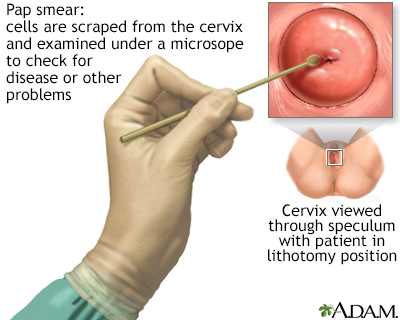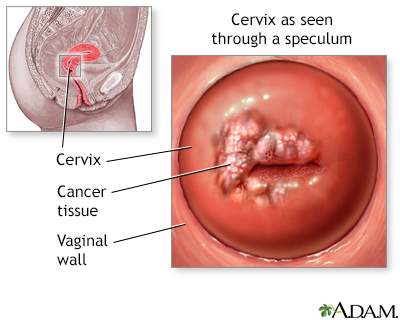
Cancer - cervix; Cervical cancer - HPV; Cervical cancer - dysplasia
Cervical cancer is cancer that starts in the cervix. The cervix is the lower part of the uterus (womb) that opens at the top of the vagina.







Worldwide, cervical cancer is the fourth most common type of cancer in women. It is much less common in the United States because of the widespread use of Pap tests to screen women for cervical cancer or its precursors.
Cervical cancer starts in the cells on the surface of the cervix. There are two types of cells on the surface of the cervix, squamous and columnar (gland cells). Most cervical cancers are from squamous cells.
Cervical cancer usually develops slowly. It starts as a precancerous condition called dysplasia. This condition can be detected by a Pap test and is nearly 100% treatable. It can take years for dysplasia to develop into cervical cancer. Most women who are diagnosed with cervical cancer today have not had regular Pap tests or the HPV vaccine, or they have not followed up on abnormal Pap test results.
Almost all cervical cancers are caused by human papillomavirus (HPV). HPV is a common virus that is spread through skin-to-skin contact and also by sexual intercourse. There are many different types (strains) of HPV. Some strains lead to cervical as well as other cancers. Other strains can cause genital warts. Others do not cause any problems at all.
A woman's sexual behavior can increase her risk for developing cervical cancer. Risky sexual practices include:
Other risk factors for cervical cancer include:
Most of the time, early cervical cancer has no symptoms. Symptoms that may occur include:
Cervical cancer may spread to the vagina, lymph nodes, bladder, intestines, lungs, bones, and liver. Often, there are no problems or symptoms until the cancer is advanced and has spread. Symptoms of advanced cervical cancer may include:
Precancerous changes of the cervix and cervical cancer cannot be seen with the naked eye. Special tests and tools are needed to spot such conditions:
If cervical cancer is diagnosed, the provider will order more tests. These help determine how far the cancer has spread. This is called cancer staging. Tests may include:
Treatment of cervical cancer depends on:
Early cervical cancer can be cured by removing or destroying the precancerous or cancerous tissue. This is why Pap tests done at the recommended times are so important to prevent cervical cancer, or catch it at an early stage. There are surgical ways to cure cervical cancer without removing the uterus or seriously damaging the cervix, so that a woman can still have children in the future.
Types of surgery for cervical precancer, and on occasion, very small early cervical cancer include:
Treatment for more advanced cervical cancer may include:
Radiation therapy may also be used to treat cancer that has returned.
Chemotherapy uses medicines to kill cancer. It may be given alone or with surgery or radiation.
You can ease the stress of illness by joining a cancer support group. Sharing with others who have common experiences and problems can help you not feel alone.
How well the person does depends on many things, including:
Precancerous conditions can be completely cured when followed up and treated properly. Most women are alive in 5 years (5-year survival rate) for cancer that has spread to the inside of the cervix walls but not outside the cervix area. The 5-year survival rate falls as the cancer spreads outside the walls of the cervix into other areas.
Complications can include:
Contact your provider if you:
Cervical cancer can be prevented by doing the following:
Centers for Disease Control and Prevention website. Clinical overview of HPV. www.cdc.gov/hpv/hcp/clinical-overview/index.html. Updated July 9, 2024. Accessed January 17, 2025.
National Cancer Institute website. Cervical cancer treatment (PDQ) - health professional version. www.cancer.gov/types/cervical/hp/cervical-treatment-pdq. Updated July 23, 2024. Accessed January 17, 2025.
Salcedo MP, Phoolcharoen N, Schmeler KM. Intraepithelial neoplasia of the lower genital tract (cervix, vagina, vulva): etiology, screening, diagnosis, management. In: Gershenson DM, Lentz GM, Valea FA, Lobo RA, eds. Comprehensive Gynecology. 8th ed. Philadelphia, PA: Elsevier; 2022:chap 29.
US Preventive Services Task Force website. Final recommendation statement. Cervical cancer: screening. www.uspreventiveservicestaskforce.org/uspstf/recommendation/cervical-cancer-screening. Last updated July 23, 2024. . Accessed January 17, 2025.
BACK TO TOPReview Date: 1/13/2025
Reviewed By: Howard Goodman, MD, Gynecologic Oncology, Florida Cancer Specialists & Research Institute, West Palm Beach, FL. Review provided by VeriMed Healthcare Network. Also reviewed by David C. Dugdale, MD, Medical Director, Brenda Conaway, Editorial Director, and the A.D.A.M. Editorial team.

|
A.D.A.M., Inc. is accredited by URAC, also known as the American Accreditation HealthCare Commission (www.urac.org). URAC's accreditation program is an independent audit to verify that A.D.A.M. follows rigorous standards of quality and accountability. A.D.A.M. is among the first to achieve this important distinction for online health information and services. Learn more about A.D.A.M.'s editorial policy, editorial process and privacy policy. A.D.A.M. is also a founding member of Hi-Ethics and subscribes to the principles of the Health on the Net Foundation (www.hon.ch). |
The information provided herein should not be used during any medical emergency or for the diagnosis or treatment of any medical condition. A licensed medical professional should be consulted for diagnosis and treatment of any and all medical conditions. Call 911 for all medical emergencies. Links to other sites are provided for information only -- they do not constitute endorsements of those other sites. © 1997- A.D.A.M., Inc. Any duplication or distribution of the information contained herein is strictly prohibited.